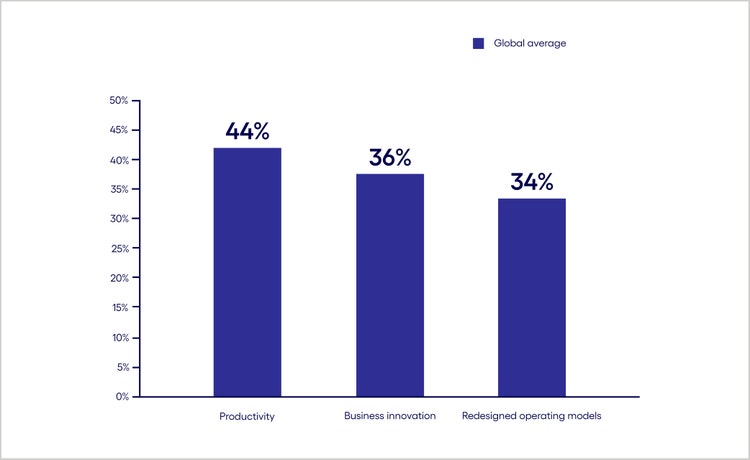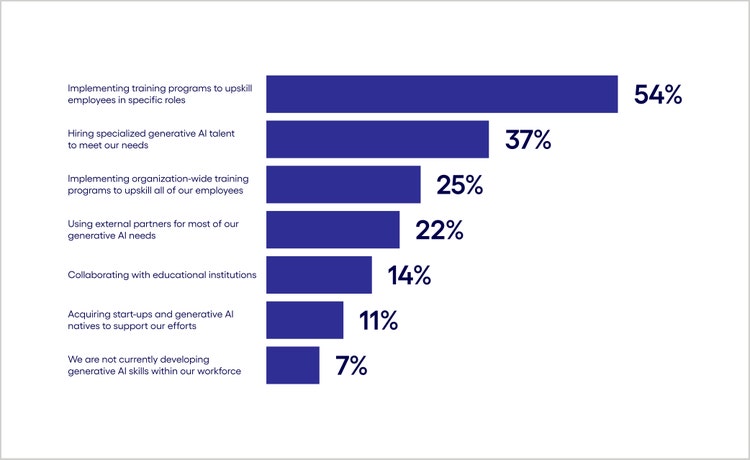
Global generative AI strategies: accelerators, inhibitors and a new focus on productivity
<p><br> <span class="small">July 30, 2024</span></p>
Global generative AI strategies: accelerators, inhibitors and a new focus on productivity
<p><b>Our global study reveals high levels of generative AI spending and leadership commitment—but also an acute sense of moving too slowly. By understanding the biggest global challenges of generative AI momentum, businesses can realize the full potential of this powerful technology.</b></p>
<p>Generative AI is widely viewed as critical to business success and is seeing significant investment from organizations around the world. In our recent study, more than 2000 global businesses across 15 countries say they’ll spend an average of $47.5 million on generative AI in their business in the current financial year, and nearly three-quarters (74%) say it’s important or very important to their continued success.</p> <p>However, there are some very real factors that could inhibit generative AI momentum, and businesses globally are already feeling the heat: Despite leadership support and ample funding, many already feel they’re moving too slowly with their generative AI strategies and that delays could hurt them competitively. There appears to be a marked gap between leadership’s strategic commitment to this new technology and business leaders’ confidence in their ability to execute on it. </p> <p>To gain a global perspective on generative AI adoption, we surveyed 2,200 business executives across 23 countries and 15 industries about their generative AI strategies, including inhibitors and accelerators to generative AI momentum, investment levels, use cases and organizational readiness to adopt the technology.</p> <p>The study builds on our previous “<a href="https://www.cognizant.com/us/en/gen-ai-economic-model-oxford-economics" target="_blank" rel="noopener noreferrer">New Work, New World</a>” report, which highlighted the potential economic gains and challenges generative AI could bring to the US economy.</p> <p>What we found is that while the majority of global businesses are seeking productivity gains with their generative AI use cases, the end goal is less about cost-cutting and more about fueling growth. </p> <p>Further, amid rampant enthusiasm for generative AI, inhibitors like talent acquisition, technological infrastructure and consumer perception threaten to stand in the way. By understanding the biggest barriers to generative AI momentum, however, businesses can overcome them and fully leverage the potential of generative AI.<br> </p> <h4>The focus of generative AI is productivity, but it’s different this time</h4> <p>Not surprisingly, respondents in our study were more interested in the productivity gains of generative AI than using the technology to revamp business and operating models or drive disruptive innovation. At a global level, 44% of companies emphasized productivity as their greatest strategic priority vs. 36% pointing to innovation and 34% to redesigned operating models (see Figure 1). This aligns with a key promise of generative AI: to help people work more efficiently and get more done.</p> <p><b>Greater focus on productivity than innovation<br> </b><i>Q: Which of the following best describes the role generative AI will play in your organization's business strategy in the next two years? (Percent of respondents naming each as a top 3 choice)</i></p>

#
<p><span class="small">Base: 2,200 senior business leaders<br> Source: Cognizant and Oxford Economics <br> Figure 1</span></p> <p>What productivity means with generative AI, however, is different from what it’s historically meant with business automation. Traditionally, businesses have equated automation productivity gains with cost-cutting: driving down the cost of output by reducing the number of people needed to get work done. </p> <p>While generative AI-driven automation will likely lower headcount to some degree, that is no longer the end goal. Instead, our study points to a shift toward redirecting the savings gained through productivity to funding innovation or discovering entirely new revenue streams.</p> <p>Consider, for instance, that 76% of businesses plan to use generative AI to create new revenue streams, and 58% are using the prospect of increased revenue to justify their business cases. This shows a marked shift in leadership thinking about productivity and automation, and it clarifies why businesses are so sure the technology is critical to their success going forward.<br> </p> <h4>Challenges inhibiting generative AI momentum</h4> <p>At the same time, most respondents (70%) believe their organization is not moving fast enough to keep pace with industry peers, and a large majority (82%) feel these delays could place them at a competitive disadvantage.</p> <p>On average, respondents believe it will take four to five years to see significant impact from generative AI. But with only 26% of respondents saying they’d implemented cross-enterprise use cases of generative AI to date, there is still a lot of room for scaling and maturing these implementations.</p> <p>To understand what will constrain or encourage adoption, we compiled a list of 18 regional and internal business factors that could either inhibit or accelerate business adoption of gen AI. We asked respondents to evaluate each factor’s potential impact on their generative AI strategy, rating it as either positive or negative on a scale of high to low impact.</p> <p>Globally, the top three inhibitors are:</p> <p style="margin-left: 40.0px;"><b>1)</b> <b>Cost and availability of talent.</b> Talent scarcity is truly a global issue. Given that the technology requires deep expertise in fields such as machine learning, data science and neural networks, the demand for such talent far exceeds the current supply.</p> <p style="margin-left: 40.0px;">This talent gap not only threatens to slow down the development and deployment of AI solutions, but it also drives up the costs associated with hiring and retaining qualified personnel—a fact lamented by respondents in our survey.</p> <p style="margin-left: 40.0px;">While 54% are investing in training and development programs to build the necessary expertise in-house, 37% plan to hire externally—with no clear idea of where that talent could be found (see Figure 2).</p> <p><b>Many will reskill, while others hold out hope for hiring <br> </b><i>Q: How is your organization currently addressing the development of generative AI skills within your workforce?</i></p>

#
<p><span class="small">Base: 2,200 senior business leaders<br> Source: Cognizant and Oxford Economics<br> Figure 2</span></p> <p style="margin-left: 40.0px;"><b>2) Consumer perceptions.</b> Many consumers harbor concerns about privacy, security and the ethical use of AI-generated content. <a href="https://www.cognizant.com/us/en/insights/insights-blog/building-consumer-trust-in-ai-wf2729750" target="_blank" rel="noopener noreferrer">Our recent survey on consumer trust</a> reveals that just one-third of US consumers trust generative AI. Mistrust stems from three key concerns: economic security, uncertainty about how the technology works and fear of its societal impacts. Shoring up consumer trust is essential to optimizing generative AI strategies.</p> <p style="margin-left: 40.0px;"><b>3) Perceived immaturity of current generative AI solutions.</b> Despite impressive advancements, many AI models still struggle with reliability, accuracy and scalability. Current generative systems can produce outputs that are impressive in certain contexts but fall short in others, often requiring human oversight to ensure quality and relevance.</p> <p style="margin-left: 40.0px;">Moreover, integrating these solutions into existing business processes can be complex and resource-intensive. The path to maturity involves extensive research and development, as well as best practices for deployment and integration.<br> </p> <h4>What’s next in generative AI strategies</h4> <p>The challenge ahead is to take full advantage of the factors that could encourage gen AI strategy success, while overcoming the inhibitors.</p> <p>Here are three actions businesses can take to see real returns from generative AI adoption.</p> <ul> <li><b>Ramp up a new talent strategy: </b>Talent remains the biggest sticking point for generative AI adoption. Businesses cite concerns about the cost and availability of talent in the external labor market, as well as the immaturity of their own talent strategies.<br> <br> While 54% of study respondents plan to implement upskilling programs for employees in specific roles, only 25% plan organization-wide training programs. To create an effective generative AI retraining program, businesses will need to conduct a detailed examination of the technology’s impact on all the roles, tasks and skills of their workforce and create a strategy that takes into consideration the vast majority of their internal talent base.<br> <br> </li> <li><b>Shore up consumer trust:</b> In addition to establishing clear ethical guidelines for AI deployment, businesses need to be fully transparent about their planned use of AI, the data used to train their models and generate outputs, and the safeguards in place to minimize negative outcomes.<br> <br> Further, business leaders should adopt a cautious approach to AI experimentation, both to limit or quickly reverse any negative results and to ensure their innovations are commercially viable. This measured approach will allow businesses to learn and adapt based on feedback, fostering a positive perception among consumers.<br> <br> </li> <li><b>Boost technology infrastructure and operational agility: </b>Finally, as market solutions mature—which could happen very quickly—it’s a good time for businesses to focus on the internal work they need to do to prepare.<br> <br> Respondents were skeptical about the readiness of their current technology infrastructure for generative AI, with just one-third rating their tech infrastructure as mature. Leaders need to ensure their IT infrastructure is ready to support AI workloads, including cloud computing and high-performance data storage solutions. Robust data governance frameworks are also needed to ensure data quality and accessibility and leverage AI-friendly platforms and tools to streamline development and deployment.<br> <br> Respondents expressed similar concerns about their operational agility. Leaders need to adopt agile methodologies like MLOps to enable iterative development and continuous adaptation. Crucially, they must foster cross-functional collaboration to ensure seamless integration of the technology across various departments and business functions.<br> </li> </ul> <h4>Navigating the future of generative AI</h4> <p>There’s no doubt businesses globally are enthusiastic about pursuing generative AI initiatives. But they also know what’s at stake and that the clock is ticking. To make the best decisions moving forward, businesses need a clear view on what could drive or constrain the success of their generative AI strategies.</p> <p>In our upcoming reports, we'll reveal what's happening with generative AI momentum in 13 countries and regions around the world. In these reports, business leaders will learn:</p> <ul> <li>The country- or region-specific factors that could either inhibit or accelerate their generative AI momentum</li> <li>Business spending levels on generative AI in each geographic location</li> <li>The timing for when businesses expect to see real impact from generative AI</li> <li>How ready businesses in their country or region are to deploy the technology</li> <li>The big distinctions in industry use cases</li> <li>The most prevalent strategies on how generative AI will be used</li> </ul> <p>Crucially, we also outline the strategic moves business leaders can make to capitalize on the accelerators and bypass the inhibitors to ensure they reap the full rewards of AI: a driving force of business success in the future.</p> <p><i>For our global report on generative AI adoption, read "<a href="https://www.cognizant.com/us/en/generative-ai-adoption" target="_blank" rel="noopener noreferrer">Building momentum: The path to confident AI adoption</a>."</i></p>
<p>Ravi Kumar S was appointed CEO of Cognizant in January 2023. In his role as CEO, Ravi sets the strategic direction of the company, promotes Cognizant’s client-first culture, and focuses on ensuring sustainable growth and driving long-term shareholder value.</p>
